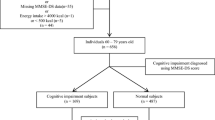Abstract
Residents living in fluorosis areas generally experienced long-term exposure to excessive fluoride in drinking water. The adverse effects of high fluoride levels on the nervous system have been studied; however, the effect of fluoride exposure on cognitive functions of elderly people in fluorosis areas is rarely reported. This study was aimed to find out the potential risk factors of cognitive impairment among elderly people who lived in fluorosis areas of China. A total of 511 subjects, aged 60 years or above, were investigated in fluorosis areas of Heilongjiang Province, Inner Mongolia Autonomous Region, Qinghai Province, and Xinjiang Uygur Autonomous Region. The Mini-Mental State Examination (MMSE) was used to examine cognitive functions of the study subjects. Based on the MMSE scores, the study subjects were divided into normal group and cognitive impairment group that consisted of mild, moderate, and severe groups. Multivariable logistic regression showed that a higher risk of cognitive impairment was associated with increased age and decreased education levels. Multiple linear regression analysis revealed that MMSE scores were negatively associated with serum homocysteine (Hcy) levels. However, both urinary fluoride and serum Hcy levels in the normal group were not the lowest among the four groups. Spearman’s correlation analysis showed that urinary fluoride levels were positively correlated with serum Hcy (r s = 0.209, P < 0.01). Our study suggests that people with cognitive impairment in fluorosis areas have elevated serum Hcy levels, which was positively correlated with urinary fluoride concentrations. A certain low dose of fluoride intake may play a potential protective rather than harmful role in cognitive functions; however, high fluoride exposure is a potential risk factor for cognitive impairment.






Similar content being viewed by others
References
Jha SK, Singh RK, Damodaran T, Mishra VK, Sharma DK, Rai D (2013) Fluoride in groundwater: toxicological exposure and remedies. J Toxicol Environ Health B Crit Rev 16:52–66
Wang C, Gao YH, Wang W, Zhao LJ, Zhang W, Han HP (2012) A national cross-sectional study on effects of fluoride-safe water supply on the prevalence of fluorosis in China. BMJ 2, e001564
Zhao Y (2006) The progress about the influence of fluorine on bone. Medical Recapitulate 12:1092–1094
Koroglu BK, Ersoy IH, Koroglu M, Balkarli A, Ersoy S, Varol S (2011) Serum parathyroid hormone levels in chronic endemic fluorosis. Biol Trace Elem Res 143:79–86
Wei W, Gao YH, Wang C, Zhao LJ, Sun DJ (2013) Excessive fluoride induces endoplasmic reticulum stress and interferes enamel proteinases secretion. Environ Toxicol 28(6):332–341
Gao Q, Guan ZZ (2010) Damages of nervous system in chronic fluorosis. Foreign medical sciences(section of medgography) 31(2):130–135
Yang CG, Ye F (2006) Effects of fluoride on IQ and central nervous system. Chin J Endemiol 25(3):352–353
Chioca LR, Raupp IM, Cunha CD, Losso EM, Andreatini R (2008) Subchronic fluoride intake induces impairment in habituation and active avoidance tasks in rats. Eur J Pharmacol 579(1–3):196–201
Trvedi MH, Verma RJ, Chinoy NJ, Patel RS, Sathawara NG (2007) Effect of high fluoride water on intelligence of school children in India. Fluoride 40(3):178–183
Ding YP, Gao YH, Sun HX, Han HP, Wang W, Ji XH (2011) The relationships between low levels of urine fluoride on children’s intelligence, dental fluorosis in endemic fluorosis areas in Hulunbuir, Inner Mongolia, China. J Hazard Mater 186:1942–1946
American Psychiatric Association (1994) Diagnostic and Statistical Manual of Mental Disorders (DSM-IV), 4th edn. APA, Washington, pp 706–708
Friedrich MJ (1999) Mild cognitive impairment raises Alzheimer disease risk. JAMA 282:621–622
Wu MS, Lan TH, Chen CM, Chiu HC, Lan TY (2011) Socio-demographic and health-related factors associated with cognitive impairment in the elderly in Taiwan. BMC Public Health 11:12
Sun SY, Zeng H, Zhang Q (2008) Research progress on cognitive function of aged people and its strategy. Chin Nurs Res 22(2):285–287
Smith AD, Smith SM, de Jager CA, Whitbread P, Johnston C, Agacinski G (2010) Homocysteine-lowering by B vitamins slows the rate of accelerated brain atrophy in mild cognitive impairment: a randomized controlled trial. PLoS One 5(9), e12244
Angevaren M, Aufdemkampe G, Verhaar HJJ, Aleman A, Vanhees L (2008) Physical activity and enhanced fitness to improve cognitive function in older people without known cognitive impairment. Cochrane Database Syst Rev 3, CD005381
Bian JC, Xian SM, Ye P, Wang XS, Liu CJ, Ma AH (1992) The influence of trace elements level of fluorosis crowd on the blood antioxidant enzymes. Chin J Endemiol 11(6):335–338
Fu D, Li ZZ, Wu Y, Wang ZC, Guan DH, Zhao GL (1991) Research of the levels of lipid peroxides and vitamin E in serum from patient with skeleta1 fluorosis. Journal of Harbin Medical University 25(2):132–133
Dong F, Zhang XC, Li SY, Zhang ZJ, Ren Q, Culver B (2005) Possible involvement of NADPH oxidase and JNK in homocysteine-induced oxidative stress and apoptosis in human umbilical vein endothelial cells. Cardiovasc Toxicol 5:9–20
Zhao ZT, Shi LQ, Lv P, Xu H, Li GS (2012) Level of reduced glutathione and oxidized glutathione in a mouse bone cell line MC3T3-E1 cells exposed to fluoride. Chin J Endemiol 31(5):511–514
Bian JC, Lin XY, Yang XX, Hou XD, Fan T, Zhu QL (2011) Human umbilical vein vascular endothelial cell injury induced by fluoride in vitro. Chin J Endemiol 30(2):142–147
Kalmijn S, Launer LJ, Lindemans J, Bots ML, Hofman A, Breteler MMB (1999) Total homocysteine and cognitive decline in a community-based sample of elderly subjects: the Rotterdam study. Am J Epidemiol 150:283–289
Acknowledgments
The authors are grateful to the Elsevier’s WebShop for providing the English language editing service. This study was supported by the National Natural Science Foundation of China (no. 81172605) and the University Science Innovation Foundation of Heilongjiang Province (no. 700233).
Author information
Authors and Affiliations
Corresponding author
Ethics declarations
Conflict of Interest
The authors declare no competing financial interests.
Rights and permissions
About this article
Cite this article
Li, M., Gao, Y., Cui, J. et al. Cognitive Impairment and Risk Factors in Elderly People Living in Fluorosis Areas in China. Biol Trace Elem Res 172, 53–60 (2016). https://doi.org/10.1007/s12011-015-0568-0
Received:
Accepted:
Published:
Issue Date:
DOI: https://doi.org/10.1007/s12011-015-0568-0




